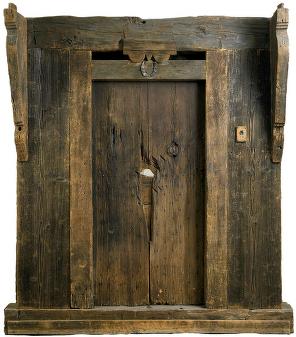
February has been flippantly called “Massacre Month” by some in Old Deerfield. Others have found in the violence of the Attack of February 1704 a promise of sure-fired success at the box office. On March 13, 1910, the Springfield Republican reported Thomas Edison was producing a silent film version of the Attack, part of which was filmed in Deerfield. They led the article with an eye-catching headline, “New Attack on Deerfield by Moving Picture Red Skins.” The reporter observes:
“History has a strong appeal to motion picture audiences, provided it is selected carefully with a view to leaving out the dry parts and presents the high color and hair-raising thrills. Indians with their hatchets, tomahawks, bows and arrows, war paint and feathers are just the people to turn loose upon a picture screen if you would make the audience sit up and give attention.”
Until recently, every February the famous Attack’s anniversary was marked with living history events and other activities. The observances are now spaced to Leap Years only, to coincide with the actual date of the event (February 29th, on the English calendar of the time). Seven years ago, on the 300th anniversary of the French and Indian attack, the museum organizations in Deerfield drew huge crowds to a battle reenactment, Native American dancers and crafters, new exhibits, and an award-winning, in depth, on-online interactive study of the five cultural groups involved in the conflict. In the midst of these sincere attempts at introducing multi-cultural perspectives and larger historic questions, there still was that good box office response. The Republican would not have been a bit surprised.
Yet, Deerfield’s 1704 commemorations were nothing compared to the nation-wide events planned for the American Civil War’s Sesquicentennial. And if the kick-off “Secession Ball” in Charleston is any indication, it’s going to be a bumpy ride. From a distance, the Ball appeared frivolous at best and provocative or racist at worst. It seemed less than respectful to the memory of America’s most bloody war.
Why is all this attention placed on war anniversaries in the first place? Why do we “study” war so?
What, if anything is gained from our fascination with “blood shed past”? Why does the study of wars take up so much space in our study of American history? Why does the American public get so excited about war anniversaries and commemorations–not to mention movies and computer devoted to these events? And why do so many history museums traffic in the long parade of man’s inhumanity to man (and to woman and children and livestock and landscape…)?
Are these activities “studies” of war or are they akin to “war mongering”– glorifying a despicable aspect of human frailty? Do museums undertaking war observances fan the public’s lurid interests or do they, by adding a little sugar of costumed pageantry to the bitter medicine of otherwise “dry” topics, generate interest in deeper questions? Do these war anniversary commemorations and events amount to generating new rubber-necking audiences at the great catastrophic blood lettings –the hamburger on the highway as it were–of human history? Or do they give us real pause to think? I don’t believe that anyone knows for sure…I rarely hear them even questioned.
The Pocumtuck Valley Memorial Association, of which I am executive director, was founded in 1870 just five years after the Civil War. The emphasis was on “memorial”–not history or heritage or commemoration or celebration, but on “remembering”– especially the common man. The founders of the PVMA were much influenced by the widespread memorial movement that followed the great blood shed of the Civil War. When PVMA opened its Memorial Hall museum in Deerfield, the museum included a “Civil War Room” filled with items (mess plates, weapons, a draft cylinder, a piece of wood from the “dead line” at Andersonville, etc.) more closely related to “current affairs” than history at that point in time. George Sheldon, the town historian who founded PVMA, was on Deerfield’s Civil War Monument Committee which raised on our Common what some believe is one of the very first Civil War monuments, a practice quickly repeated thereafter in towns across America, both North and South. These were not just monuments to the generals– but to the “boys”–which many of them literally were. Listed are not just the glorious battle dead, but also those who died in prisons and through disease. Most often these monuments are topped with a mournful solitary infantryman, head bowed in sorrow. Very moving; very tasteful. Perhaps a better model of remembering.
Or would humankind be even better off if we followed the advice from that old African American spiritual: “Ain’t going to study war no more!” a refrain borrowed from the words of the ancient Hebrew prophet Isaiah as found in Chapter 2, verse 4–at the close of the passage where the immortal words of Messianic hope “they shall beat their swords into plow shares” are also found.
This phrase inspired a garden sculpture “Let Us Beat Swords into Plowshares” now in the gardens of the United Nations. Created by Evgeniy Vuchetich, the bronze statue presents the figure of a man holding a hammer in one hand and, in the other, a sword which he is making into a plowshare, symbolizing man’s desire to put an end to war and convert the means of destruction into creative tools for the benefit of all mankind. Ironically the statue was a gift in 1959 from our then Cold-War adversaries in the Soviet Union.
Maybe we should spend more time commemorating, reenacting, celebrating, “studying” the peace makers–while following the advice of the Springfield Republican to make sure we include “the high color ad hair-raising thrills.”


